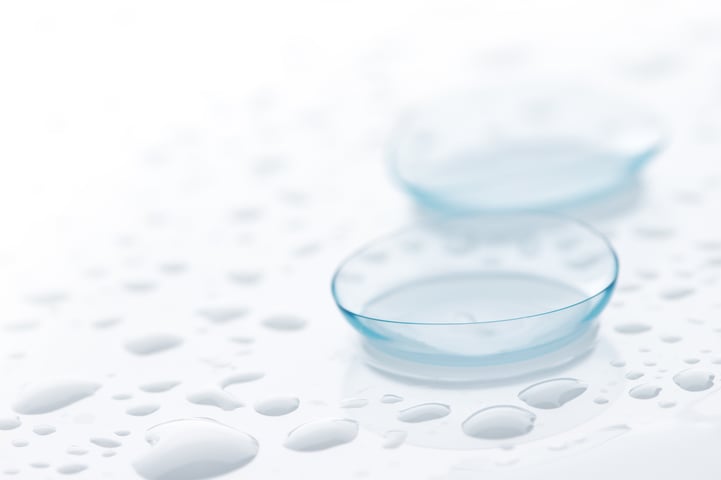
Studies show that a significant percentage of contact lens users decide to discontinue the use due to ocular symptoms such as dryness and discomfort 1. There are number of factors affecting the usability of the contact lens. Contact lens should support a continuous tear film, i.e. it should not dehydrate, for optimum visual clarity. It should also resist the sorption of tear components such as lipids, proteins, and mucins as deposition can lead to decreased visual clarity and discomfort. Wettability of the surface affects both the tear film as well as biocompatibility of the lens. In addition to the good wettability, contact lenses should be highly permeable to oxygen to support continuous wear, for example, overnight 2.
The first soft contact lenses were commercialized in 1970 and made of pHEMA. They were easily adopted by the users due to their relative comfort compared to previously used PMMA lenses. The main problem with the pHEMA-based materials is their inadequate oxygen transmissibility which prevents an overnight use of the lenses. This led to the development of silicone hydrogel contact lenses that incorporated silicon as siloxane polymers into the lens material to improve oxygen permeability. However, the use of siloxane also led to a hydrophobic surface which is poorly wetted.
Several methods have been used to improve the wettability, including surface treatments such as plasma, coatings, and incorporation of wetting agents. Plasma is a highly reactive gas that interacts with the surface groups on the contact lens. When oxygen is present, it oxidizes the siloxane groups to silicate which makes the surface more hydrophilic. Plasma treatment offers a simple and well-established method, but the effect decreases over time. Coatings offer a more stable solution and can also possess additional benefits such as anti-microbial properties. Incorporation of high molecular weight wetting agents into the polymer matrix of the lens is also one approach to overcome the wettability issues.
To study the effect of different modifications on the wettability of the contact lens, contact angle measurements are commonly used. To read more about wettability and how it can be measured, please download the overview below.
Discover why contact angle is essential for adhesion, coatings, and quality control. Learn how surface wettability impacts product performance.
Discover why PFAS-free coatings are needed, the challenges they present, and key strategies for developing high-performance alternatives.
At the heart of droplet formation are two key molecular forces: cohesion and adhesion.
Contact angle measurements provide a golden standard for evaluation of surface properties for quality control.
Contact angle is the angle a droplet forms in contact with a solid surface. Thermodynamically, it is a balance between cohesive and adhesive forces.
This blog post discusses the importance of adhesion in the lithography process and how to predict adhesion with contact angle measurements.
HMDS is used to render the surface of silicon more hydrophobic and thus to match better with the chemistry of the photoresist.
This blog post explains the concept of RCA cleaning and it's relation to contact angle.
Contact angle measurements can be used to evaluate the cleanliness of silicon wafers.
